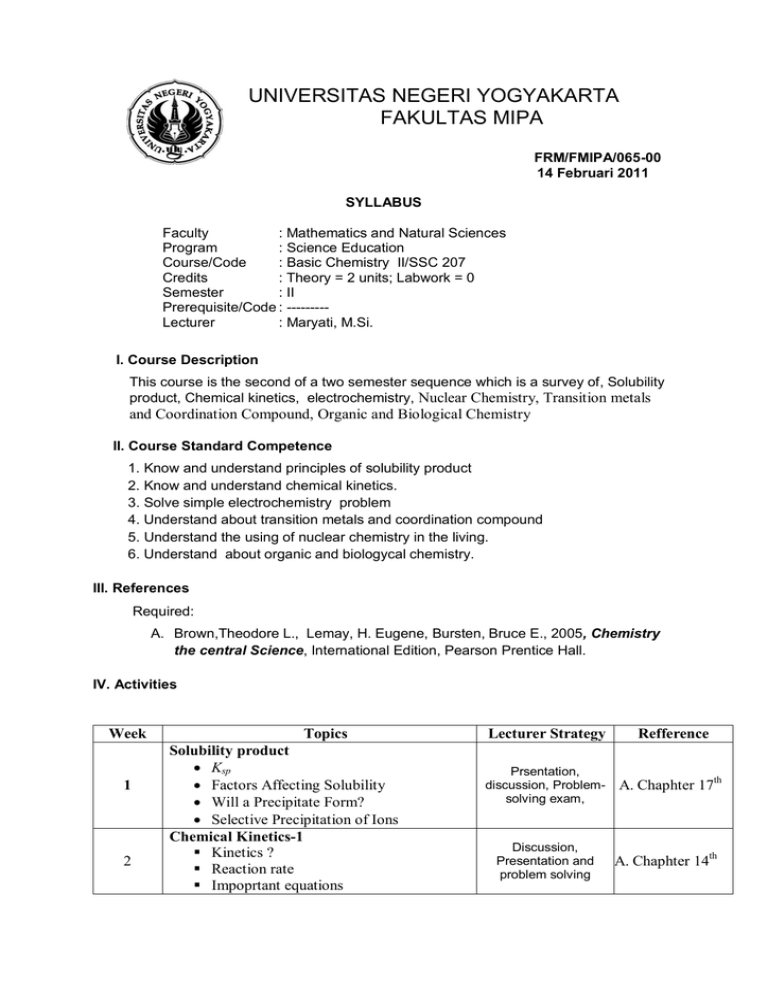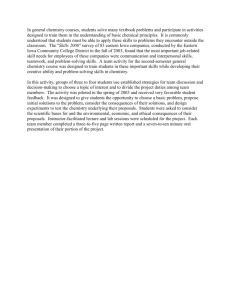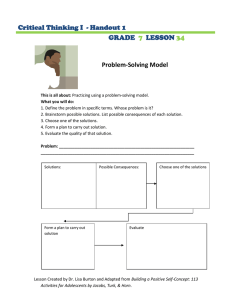
UNIVERSITAS NEGERI YOGYAKARTA
FAKULTAS MIPA
FRM/FMIPA/065-00
14 Februari 2011
SYLLABUS
Faculty
: Mathematics and Natural Sciences
Program
: Science Education
Course/Code
: Basic Chemistry II/SSC 207
Credits
: Theory = 2 units; Labwork = 0
Semester
: II
Prerequisite/Code : --------Lecturer
: Maryati, M.Si.
I. Course Description
This course is the second of a two semester sequence which is a survey of, Solubility
product, Chemical kinetics, electrochemistry, Nuclear Chemistry, Transition metals
and Coordination Compound, Organic and Biological Chemistry
II. Course Standard Competence
1. Know and understand principles of solubility product
2. Know and understand chemical kinetics.
3. Solve simple electrochemistry problem
4. Understand about transition metals and coordination compound
5. Understand the using of nuclear chemistry in the living.
6. Understand about organic and biologycal chemistry.
III. References
Required:
A. Brown,Theodore L., Lemay, H. Eugene, Bursten, Bruce E., 2005, Chemistry
the central Science, International Edition, Pearson Prentice Hall.
IV. Activities
Week
1
2
Topics
Solubility product
Ksp
Factors Affecting Solubility
Will a Precipitate Form?
Selective Precipitation of Ions
Chemical Kinetics-1
Kinetics ?
Reaction rate
Impoprtant equations
Lecturer Strategy
Refference
Prsentation,
discussion, Problemsolving exam,
A. Chaphter 17th
Discussion,
Presentation and
problem solving
A. Chaphter 14th
3
4
5
6
7
8
9
10
Reaction rate and stoichiometry
Factors that affect reactions rate
Chemical Kinetics-1
Rate laws
First and second order processes
The Half-life
Arhenius equation
Transitional metals and Coordination
Chemistry
Transition metals
Coordination compound
Ligands
Name of coordination
compounds
Transition metal trace elements in
humans
Electrochimisty
Electrochemical reaction
Balancing reduction dan oxidation
equation
Voltaic cells
EMF (electromotive force)
Aplication of redox reaction
Batteries and fuel cells
Corosion
Electrolysis
Nuclear Chemistry
The Nucleous
Isotop
radioactivity
Type of radioactive decay
Kinetics of radioactive decay
Energy in nuclear radioactive decay
Nuclear fission
Nuclear reactor
Nuclear fussion
Biological effects of radiation
MIDDLE TEST
Organic and Biological chemistry
Organic chemistry-1
Alkanes (properties, Isomers,
Organics nomenclature,
Cycloalkanes, Reaction)
Alkenes (properties,
nomenclature, Cycloalkanes,
mechanisme of aditions
Reaction)
Alkynes (nomenclaturem
aromathic HC, functional group)
A. Chapter 14th
Problem-solving
exam, cumulative
final
B. Chapter 23th
Problem-solving
exam, cumulative
final
Problem-solving
exam, cumulative
final
A. Chapter 20th
Problem-solving
exam, lab
participation,
cumulative final
A. Chapter 20th
Discussion,
prsentation and
Problem-solving
A. Chapter 21th
Discussion,
presentation and
problem solving
A. 21.7-21.9
A. Chapter 24th
Discussion,
presentation,
Problem-solving
cumulative final
11
12
13
14
15
Organic chemistry-2
Alkohols
Eters
Carbonyl compound
Aldehydes
Ketones
Carboxylic acids
Esters
Amides
Amines
Chyrality
Amino Acids and protein
Amino acid (types and structure)
Properties of amino acids
Usefullnes of protein
Polymer of amino acids
Carbohydrates
Mono-, di-, polyssakarida
Identify of caarbohydrate
Lipid
Lipid acid
Strucutre of lipid
Saponification
16
Final exam
A. Chapter
24th
Discussion and
Presentation
A. Chapter 24th
Discussion and
presentation
Discussion,
presentation,
Problem-solving
cumulative final
Discussion,
presentation,
Problem-solving
cumulative final
A. Chapter 24th
A. Chapter 24th
A. Chapter 24th
Discussion,
presentation,
Problem-solving
cumulative final
Indiviual
participans
Cumulative final
V. Assessment
No
Component
Weight (%)
1
In-Class Participation
10%
2
Assignments
20%
3
Mid-Term Exam
30%
4
Final Exam
40%
Total
100%
Yogyakarta, february 12th 2013
Lecturer





